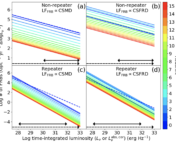Title: Fast radio bursts as synchrotron maser emission from decelerating relativistic blast waves
Authors: Brian D. Metzger, Ben Margalit & Lorenzo Sironi
First Author’s Institution: Columbia University, New York, NY
Status: Submitted to MNRAS, open access on the arXiv
Ever since Fast Radio Bursts (FRBs) were first reported in the literature in 2007, they’ve remained an exciting and mysterious group of astrophysical phenomena. Until 2014, there were only six signals recorded in the literature, all from the Parkes Observatory in Australia. However, thanks to advances in technology and instrumentation, we have seen a flurry of FRB detections from various other radio observatories in the past five years, bringing the known total up to at least 65. These FRB signals have mostly been wildly energetic one-time bursts, releasing more energy in fractions of a second than our Sun does in decades.
Repeating FRB signals also exist. FRB 121102 was the first detected repeating FRB, observed to be a repeater by the Arecibo Observatory in 2015 when they detected ten FRBs at a location in the sky near a FRB they discovered three years earlier. The second repeating FRB was only recently discovered in 2018 by the CHIME/FRB collaboration during a testing phase. These repeating FRB signals provide a tantalizing window through which scientists can debate the nature and origins of FRBs. Multiple possible origins of FRBs have already been covered here on astrobites: neutron star mergers, flaring stars, and dark matter-induced collapse of neutron stars. Today’s paper focuses on the properties of FRB 121102 to suggest that FRBs may occur as laser-like emission from decelerating shock waves, preferably—but not necessarily—from magnetars, which are neutron stars with tremendously powerful magnetic fields.
Today’s Model of FRB Emission
The authors start by outlining the properties of FRBs, particularly FRB 121102, that help motivate their model. FRBs are observed to have large dispersion measures, which means their radio signals “smear” a lot in time and frequency as they travel through free electrons (as explained further in this astrobite, lower frequency signals arrive later depending on how many free electrons the burst passes through). This measurement is indicative of an extragalactic origin, as the Milky Way alone cannot produce enough free electrons to explain the dispersion measure. In fact, FRB 121102 was traced back to a low-mass star-forming galaxy, with accompanying persistent radio signals and an enormous rotation measure (“twisting”) of these signals, suggesting that this FRB was in an environment of dense magnetized plasma. The combination of extreme environments and short burst durations points to compact objects, such as magnetars, as a likely source of FRBs. The measurement of high linear polarizations (how confined a wave is along the direction of propagation), which would require environments similar to those naturally occurring in magnetars, further supports this scenario. However, whether these properties observed in FRB 121102 generalize to all repeaters, let alone one-off FRBs, is unclear. As other models predict an object putting energy into a dense external environment, the authors opted to develop a more general source-independent model of emission of FRBs, rather than focus specifically on emission from magnetars.
Recent results from astrophysical simulations led the authors to develop a model where FRBs can occur through a process called “synchrotron maser emission.” Through a variant of this process, incredibly fast shock waves moving towards the observer could produce particles that would then collide with particles from earlier flares, producing enormous magnetic fields. Synchrotron radiation would then be produced by radially accelerated charged particles propagating quickly through these strong magnetic fields, creating an unstable “population inversion,” where more atoms are in higher energy levels than in lower ones. Some of these photons generated by synchrotron emission would collide into other atoms, causing a chain reaction-like emission (i.e., a maser) propagating coherently outward in the form of fast radio bursts (Figure 1). As time goes on and the shocks decelerate, the radio signals would drift downwards in frequency—a unique property observed in sub-bursts (which make up some of the individual bursts) from both observed repeating FRB signals.

What Next?
Fortunately, this detailed quantitative theory has numerous, specific observational predictions—for example, this model predicts that all future FRBs would show signals with this downward drift in frequency. Other observational predictions include afterglow emission in the gamma-ray or X-ray bands, a lower rate of FRB detections at lower radio frequencies, and “breaks” in bursts after major flares. These observational predictions can be tested with upcoming collaborations: the Australian Square Kilometer Array Pathfinder (ASKAP) has already discovered multiple FRBs and hopes to be able to find the FRBs’ host galaxies, and once CHIME/FRB becomes fully operational, it is expected to find up to 10 FRBs each day. Whether this model will stand the test of time (and observations) for repeating FRBs, one-off FRBs, or both, is so far uncertain, but one thing is clear: this model comes at an exciting time for the FRB community!




